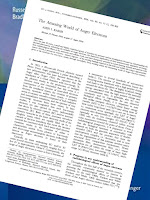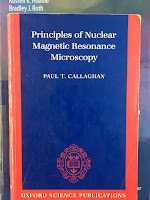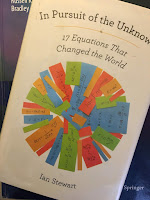I recently obtained through interlibrary loan a copy of
The Correspondence Between Sir George Gabriel Stokes and Sir William Thomson, Baron Kelvin of Largs, edited by
David Wilson. This wonderful collection of over 650 letters spans the years 1846 to 1901.
Robert Purrington, in his book
Physics in the Nineteenth Century, claims that “the Thomson-Stokes correspondence is one of the treasures of nineteenth-century scientific communication.” I thought I would share a few excerpts from these letters with the readers of this blog.
Stokes (1819-1903) was the older of the two men. For years he served as the
Lucasian Professor of Mathematics at the
University of Cambridge. I have
discussed him in this blog before. In the 4th edition of
Intermediate Physics for Medicine and Biology,
Russ Hobbie and I mention Stokes in connection to
Stokes’ law for the drag force of a sphere moving in a viscous fluid, and the
Navier-Stokes equations of
fluid dynamics.
Kelvin (1824-1907) was five years younger than Stokes. He was born with the name William Thomson, but was made a Lord in 1892 and was thereafter referred to as Lord Kelvin. Russ and I don’t mention Kelvin in
IPMB, but we do mention the
unit of absolute temperature named after him. He spent his career at the
University of Glasgow in Scotland, and is remembered for many accomplishments, but primarily for his contributions to
thermodynamics.
Stokes’ and Kelvin’s letters were full of mathematics (Stokes was primarily a mathematical physicist) and critiques of the many famous physicists of their era. They spent a lot of time trying to obtain copies of papers. In the days before the internet, or even the Xerox machine, making a copy of a scientific paper was not easy, and they were constantly lending out the few copies they possessed. In some years, their letters were primarily about reviewing manuscripts, as both men served as editors of journals at one time and as reviewers for journals at another. Most commonly Stokes, as editor, was trying to coax Kelvin to complete his reviews on time.
A letter of April 7, 1847—between two relatively young and up-and-coming physicists—highlights the different areas of interest of the two men.
My Dear Stokes,
Many thanks for your letters…..I have been for a long time thinking on subjects such as those you write about, and helping myself to understand them by illustrations from the theories of heat, electricity, magnetism, and especially galvanism; sometimes also water. I can strongly recommend heat for clearing the head on all such considerations, but I suppose you prefer cold water….
Yours very truly, William Thomson
In this letter from Oct 25, 1849, Kelvin congratulates Stokes on becoming the Lucasian Professor.
My Dear Professor
I have been daily expecting to hear of the election of a Lucasian Professor and whenever the Times has been in my hands I have looked for such a proceeding in the University Intelligence, and now I am glad to be able to congratulate you on the result…
Yours sincerely,
William Thomson
Sometimes the two engaged in a bit of trash-talking about other scientists. In a Jan 6, 1851 letter, Stokes adds a pugnacious postscript.
My Dear Thomson,
…..
Yours very truly,
G. G. Stokes.
P.S. Have you seen Prof Challis’s awful heterodoxy in the present no. of the Phil. Mag. I am half inclined to take up arms, but I fear the controversy would be endless.
Readers of
IPMB will recall the
cable equation in Chapter 6 that describes the electrical properties of a
nerve axon. This equation was not originally derived to model an axon, but instead was proposed by Kelvin to describe a
submarine telegraph cable. Kelvin was deeply involved with the
trans-Atlantic cable, and in this Oct 30, 1854 letter he described this work to Stokes.
My Dear Stokes,
An application of the theory of the transmission of electricity along a submarine telegraph wire, which I omitted to mention in the haste of finishing my letter on Saturday, shows how the question raised by Faraday as to the practicability of sending distinct signals along such a length as the 2000 or 3000 miles of wire that would be required for America, may be answered. The general investigations will show exactly how much the sharpness of the signals will be worn down, and will show what the maximum strength of current through the apparatus in America, would be produced by a specified battery action on the end in England, with wire of given dimensions etc.
The following form of solution of the general equation
σ2kc dv/dt = d2v/dx2 - hv
which is the first given by Fourier, enables us to compare the times until a given strength of current shall be obtained, with different dimensions etc of wire….
Yours always truly,
William Thomson
Neither scientist could properly be called a biological physicist. Medicine and biology almost never appear in their letters (unless one of them is sick). Kelvin once brought up a biological topic in his Jan 28, 1856 letter.
My Dear Stokes,
…Have you seen Clerk Maxwell’s paper in the Trans R S E [Transactions of the Royal Society of Edinburgh] on colour as seen by the eye?...do you believe that the whites produced by various combinations, such as two homogenous colours, three homogeneous colours, etc. are absolutely indistinguishable from one another and from solar white by the best eye?...Are you at all satisfied with Young’s idea of triplicity in the perceptive organ?
Yours very truly,
William Thomson
Stokes’ curt reply on Feb 4 indicated he could not have been less interested in the topic.
My Dear Thomson,
….I have not made any experiments on the mixture of colours, nor attended particularly to the subject….
Yours very truly,
G. G. Stokes
Once Kelvin was late getting some page proofs sent to Stokes, and in a Jan 20, 1857 letter he received a stern tongue lashing (one suspects,
tongue-in-cheek).
My Dear Thomson,
You are a terrible fellow and I must write you a scolding…Hoping you will be more punctual for the future I remain
Yours most sincerely,
G. G. Stokes
This was not the last time Kelvin was slow in responding to Stokes, and he often apologized for being late. He was tardy once when reviewing one of Maxwell’s papers for a journal. To me, Maxwell is a giant of physics, to be spoken of in the same category as
Newton and
Einstein. But for Kelvin, reviewing one of Maxwell’s papers was just another chore he needed to find time to do.
Although most of the letters were about science, personal matters were sometimes mentioned. Kelvin wrote a Dec 27, 1863 letter of consolation after
scarlet fever took the life of Stokes’ infant child. Stokes himself was also ill with the disease.
My Dear Stokes,
I am very sorry to hear of the loss you have had and I feel much concerned about the danger you have yourself suffered. I hope you are still improving steadily, and that you will soon be quite strong again….
Yours always truly,
W. Thomson
I hope the others of your family have perfectly recovered, if not escaped the scarlet fever.
When Kelvin became a
Lord, Stokes’ Jan 2, 1892 letter had a bit of fun with the event. But afterwards, his letters were always addressed to Kelvin rather than Thomson.
My Dear Lord (What?)
I write to congratulate you on the great honour Her Majesty has bestowed on you, and through you on science, by creating you a Peer. At the same time I may add my congratulations to those of my wife to The Lady Thomson, or whatever she is to be called. I was speculating whether you would be Lord Thomson, or Lord Netherhall, or Lord Largs, or what. Time will tell….
Yours sincerely,
G. G. Stokes
They didn’t always agree on scientific issues. In an Oct 27, 1894 letter, the 75-year-old Stokes’ humerously addresseed a disagreement about the behavior of a fluid in some container.
My Dear Lord Kelvin,
…..perhaps you think to demolish me by saying, Let the vessel be rigid but massless. Well. There is life in the old dog yet….
Yours sincerely,
G. G. Stokes
I found it fascinating to listen as they corresponded about the important physics of their era. For instance, they discussed
Rontgen’s discovery of
X-rays extensively in 1896, and considered writing a joint note about their electromagnetic nature. They debated
Becquerel’s discovery of
radioactivity from
uranium in 1897. Their last letter, in 1901, analyzed a problem from fluid dynamics and contained mathematical equations.
I didn’t have time to read all the letters, but I did spend most of a Saturday sampling many of them. The letters provide a valuable glimpse into the relationship between two intelligent yet human scientists. Wilson lists a few quotes at the start of his book, with the last one by
Arthur Schuster (1932) stating
I shall always remember Lord Kelvin, as he stood at the open grave, almost overcome by his emotion, saying in a low voice: “Stokes is gone and I shall never return to Cambridge again.”









